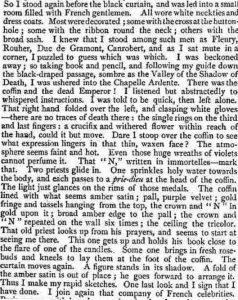Topical Events
Incidents of breaking domestic news, such as the death in Britain of the exiled Emperor Napoleon III, also called the home-based Specials into action. In an unexpected sequel to his work covering the Franco-Prussian War, Sydney Prior Hall was summoned to the Chapelle Ardente at Chislehurst on 14 January 1873 to witness the lying in state of the deposed French leader ‘clothed in the uniform last worn at Sedan’ on behalf of the Graphic’s readers (‘The Late Emperor Napoleon III’, Graphic, 25 January 1873, p.71).

Extract from Sydney Prior Hall, ‘The Last Levee of Napoleon III’, Graphic, 25 January 1873, p. 86.
Newspaper Image © The British Library Board. All rights reserved. With thanks to The British Newspaper Archive (www.BritishNewspaperArchive.co.uk).
I was beckoned away; so taking book and pencil, and following my guide down the black-draped passage, sombre as the Valley of the Shadow of Death, I was ushered in to the Chapelle Ardente. There was the coffin and the dead Emperor! I listened but abstractedly to whispered instructions. I was told to be quick, then left alone.
Revealing the workings behind the making of the final sketch, the artist gives the reader access to his perceptions as he records the essential features of the scene before him:
That right hand folded over the left, and clasping white gloves – there are no traces of death there: the single rings on the third and last finger: a crucifix and withered flower within reach of the hand, could it but move. Dare I stoop over the coffin to see what expression lingers in that thin, waxen face? The atmosphere seems faint and hot. Even those huge wreaths of violets cannot perfume it. That ‘N’ written in immortelles – mark that. …The curtain moves again. A fold of amber satin is out of place; he goes forward to arrange it. Thus I make my rapid sketches. One last look and I sign that I have done. I join again that company of French celebrities.
![[Sydney Prior Hall,] ‘The Last Levee: Inside the Chapelle Ardente at Chislehurst, Jan. 14, 1873, at the lying in State of Napoleon III’, The Graphic, 25 January 1873, p. 73.](https://research.kent.ac.uk/victorianspecials/wp-content/uploads/sites/2017/2017/01/5-3-extract-300x212.jpg)
[Sydney Prior Hall,] ‘The Last Levee: Inside the Chapelle Ardente at Chislehurst, Jan. 14, 1873, at the lying in State of Napoleon III’, The Graphic, 25 January 1873, p. 73.
© National Portrait Gallery, London [CAP00493]